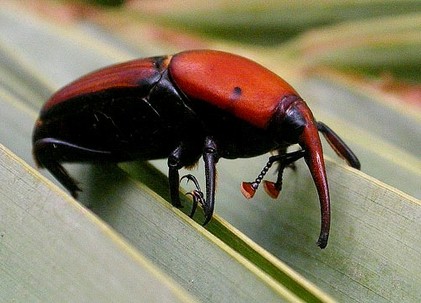SERENA ECOSERVIZI
Main menu:
- Home Page
- About us
- Hygien environmental
- Cleaning services
- Catalog
- OFFERS
- OUR PROJECTS
- Blog
Red weevil
Hygien environmental > Pest Control > Weed

The adults of Rhynchophorus ferrugineus are active both day and night. They are strong flyers, able to reach new guests within 1 km.
The oviposition usually takes place at the portions younger and hold the plant or in wounds of the trunk or spine foliar. A female can lay up to 200 eggs at a time.
After hatching the larvae make their way to the interior of the plant, digging tunnels thanks to the robust masticatory apparatus and damaging especially the trunk area immediately below the crown foliar. The larval period lasts an average of 55 days.
The larvae pupate generally at the base of the plant, forming oval cocoons of palm fibers outside of the trunk. After emergence from the pupa adults remain within these cocoons for 4-17 days (mean 8 days), reaching sexual maturity.
The complete life cycle from egg to flickering, lasts an average of 82 days. The adults have a life span of about 2-3 months.
It has been estimated that, in the absence of limiting factors, a single pair of Rhynchophorus ferrugineus can give life, over 4 generations, about 53 million copies
Along between 19 and 45 mm, has a livery of red-brownish, with black specks in the upper part of the chest. It has a long curved beak, which is more pronounced in the male and covered by a thick brownish hair, are inserted at its base antennas. The width of the body varies between 11.5 to 15.5 mm, the elytra have a streak end and are darker in color than the pronotum. The scutellum is around a quarter of the elytra rather broad.
Eggs [edit] They are thin, oblong, cream-white, long on average 2.62 x 1.12 mm, the female lays them a number ranging between a few dozen and several hundred.
Larva [edit] The larvae are 35-50 mm long, whitish with brown head, the chewing mouthparts is well developed and highly chitinizzato while the white body, composed of 13 segments, has no legs.
Pupa [edit] The pupa average size of 35 mm x 15 mm, and is initially creamy-white and then brown in the later stages: Cocoon-Larva-Pupa-grown specimen
The control of Rhynchophorus ferrugineus is problematic and very difficult due to the competition of multiple factors that favor the pest. The adults move with ease and can circumvent any barriers or containment expanding foci of infestation.
Our curative chemical treatments require the use of systemic insecticides and early diagnosis of the infestation; late curative treatments, as well as being unnecessary to resolve the attack in the infested plant, are also of limited effectiveness.
The use of traps, point to a more effective use of attractants combined (pheromone attractants and sugar-based) and the importance of the provision of the traps in relation to height. Based on the results achieved so far is estimated that the technology still needs to be refined to further enhance the prospects of success.
is of fundamental importance prophylaxis to prevent the expansion of the pest, taking early on outbreaks of infestation. In this regard, on the basis of objective difficulties of early diagnosis of the attacks and to intervene with curative interventions, prove of particular importance the following actions:
monitoring;
maintenance of trees in good nutritional condition and phytosanitary measures, as the susceptibility to attack by wood-boring insects increases in plants under conditions of stress or weakened;
the adoption of pruning techniques and treatments that reduce the possible sites of penetration of the insect;
the destruction of outbreaks of infestation, represented by palm trees attacked by adopting measures intended to prevent the flickering of adults (removal of trees, construction of physical barriers of containment, destruction with the shredding and burning in a very short time).